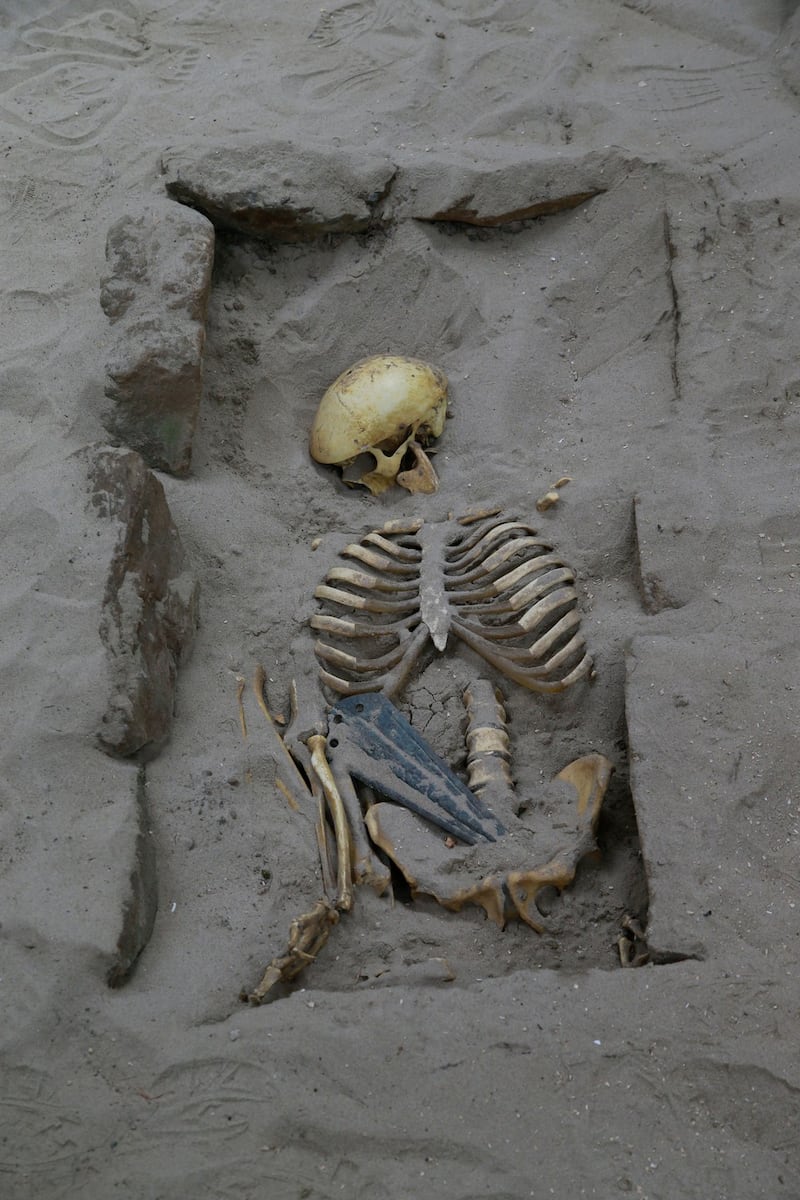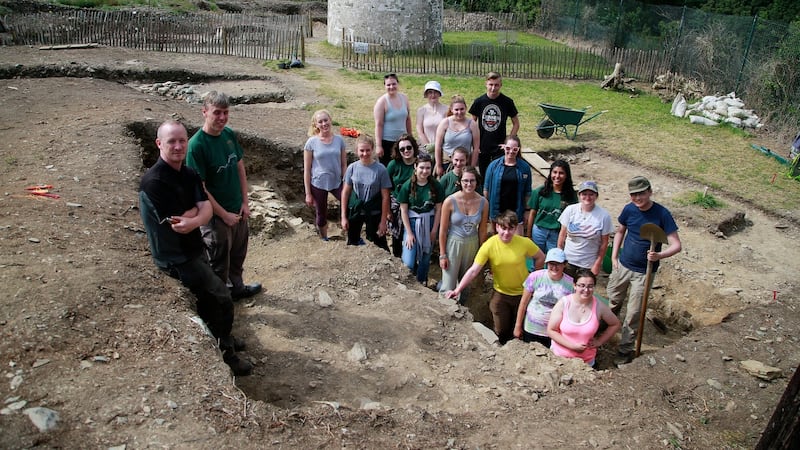Three years ago when Chris Hayes was hired as park manager for the National Heritage Park in Wexford he learned that beyond all the meticulously reconstructed crannogs and ring forts, up on the Hill of Carrig was the first Norman settlement in Ireland. In fact this year is the 850th anniversary of both that settlement and the Norman invasion.
So a few years ago Hayes set about clearing away the trees, invited Dr Denis Shine from the Irish Archaeology Field School to train student archaeologists on the site, and now it's the home of a busy archaeological dig.
The National Heritage Museum was established in the 1980s as an open air museum showcasing 16 historical settlements recreated based on the best archaeological evidence and manned by costumed guides. It’s brilliant. You can, if you wish, book a night in the reconstructed ring fort on Airbnb.
“But people had stopped going up the Hill of Carrig,” says Hayes. “The place was completely overgrown.”
There had been two digs there previously in 1985 and 1987, coinciding with construction of the M11. The road-builders steered clear of the site of the castle but Shine notes that “a lot of the [Norman] town is under the motorway”.
Nowadays they might have gone a slightly different route...We have a different level of importance put on the past than other generations had.”
Archaeological digs were low on the agenda back then. Hayes tells a story of the archaeologist who ran the 1985 dig asking a senior civil servant about delayed payments, only for him to turn to a handler and say, “we’re paying for this?”

There were other reasons that people were less than enthusiastic about the site. It was the first settlement of the Norman knight Robert FitzStephens, who came here as a mercenary to help Dermot MacMurrough reclaim his lands in 1169.
“Dermot MacMurrough invited the Normans in,” says Hayes. “That’s painful for the Irish people. It just wasn’t a subject to be dealt with in the 1980s...Commemorating the Norman invasion?” He laughs. “Are you mad? We’d be lynched.”
“The past is always politicised,” Shine tells me a little later. “Forty years ago we would still have been fed that refrain of ‘800 years of English occupation’... We’re comfortable enough telling that story now.”
Motte and bailey
Up on the Hill of Carrig there are a few odd looking buildings. There’s a concrete castle, built as part of a training programme, and a disused reconstruction of a motte and bailey – a typical Norman fortification – that is now the base of operations for Shine and the international students he helps to educate. Across a trench on the settlement itself there’s a replica of a round tower built in the 19th century to commemorate soldiers who fought in the Crimean War.
In the reconstructed motte and bailey the students are on a break drinking tea and eating bourbon biscuits. In one of the offices there’s a glass case with some biscuits in it and a sign that says “break glass in case of emergency”.
In another post-excavation co-ordinator Maddie Harris shows me various shards of pottery found on site. They are in a plastic tray, and she identifies them depending on their colour as "English", "Irish" or "French" pottery. They once found something very rare on the site, a piece of pottery shaped like an antler that was part of a type of animal-shaped jug used for special ceremonies called an "aquamanile."

“The whole site stopped for that,” she says. “We’d never seen that before and haven’t seen it since and probably won’t again.”
"We'll find the other antler," promises senior site manager Richard Reid. "We will find the rest of it."
They have also found fallow deer bones because this was also the Normans’ first deer park. “Starting a deer park was a massive statement,” says Shine. “They were saying, ‘we have the ability to do this. We will bring in whatever animals we want, and we will tame your landscape’.”
The native Irish wouldn’t have seen anything like the Normans before, says Shine. “They were a game-changer. The Irish didn’t use heavy cavalry. They didn’t have stirrups or saddles…They were the nuclear deterrents of the day.”
"They'd take over and find a dominant place on the landscape," says Hayes. "They would build a castle, and then a village would grow around it. That's exactly what happened here…Once they controlled the narrowest crossing on the river [Slaney] they controlled all the trade up to Enniscorthy. "
Pottery kiln
Do the archaeologists have a wish list of things they want to find here?
“A pot of gold,” says Hayes, but he’s joking.
“A pottery kiln,” says Harris. “There hasn’t been a big kiln found in Wexford…There are hints there could be a kiln onsite but we’re yet to find a structure.”

The settlement here lasted around 150 years, but there is, luckily, plenty of historical documentation on the site. It was originally made of timber but they know that there was a stone castle built there by 1210. The documents mention a chapel, a castle and a hall, although Shine thinks that it is possible the hall and the castle are one and the same thing.
As we talk they’re trying to find the east end of the chapel. “We’d love to find evidence of an altar or a stained-glass window,” says Shine.
What’s the best thing he has ever found?
“My wife,” he says, and everyone laughs.
“The neatest thing I’ve ever found is a bronze age burial and [in it] was a small animal. It ended up being a rabbit, and rabbits are meant to have been brought in by the Normans…The person running the site got excited thinking we were going to rewrite Irish history with rabbits in the bronze age. But it turned out the rabbit had just burrowed in there and died.”
Hayes recalls an archaeology lecture that he attended where the lecturer asked anyone who was there because of Indiana Jones to leave. He laughs. "And people got up and left!"
Later I ask some of the interns if they’ve seen the Indiana Jones films. Some have. Some sigh at the question.
American intern Daphne Shigel just loves history, and wants a job where she works outside.
Gwyneth Evans, who is preparing a presentation for an open day here on July 26th, says she used to get in trouble as a child for digging holes in the ground.
“When you find something here it was probably important to somebody at some point. A piece of pottery might have been someone’s favourite bowl.”
Clover Little, from Canada, recently found a coin-like "token" dating from the 1790s which was probably dropped by a labourer taking stone from the site. "At a site like this something like that is amazing because you're not expecting to find lost treasure."
Carbon dating
Out in the sun students are kneeling with trowels, digging with mattocks or pushing wheelbarrows around. Shine also notes the more additional high-tech methods at their disposal. Their findings are sent off for testing and carbon dating to an array of universities.
Richard Reid points me to a “sondage”, a deep cut in the ground in one of the “cuttings” where the clay is greyer. “They’re getting down to the 12th century levels,” he says. “What we’re looking at is the muck that Robert FitzStephens and the Norman knights would have been walking around on in 1169.”

There were five knights originally, he says, who came with two horses each, eight or 10 archers each, as well as their wives and families. “So maybe 100 people lived here then.” A lot of their work, he says, is about figuring out what these people were thinking.
By the 1330s the Normans had retreated to the Wexford pale and the site is recorded as being in ruins.
“And then you hear of people coming to take stone,” says Reid. “In 1800 an estate house goes in down the road. Then there’s the bridges down in Wexford, and then the round tower goes up in 1857. They’re all taking the stone.”
Because of its teaching function the archaeology at a field school dig moves slowly, but this is a bit of a relief to Reid who worked on commercial construction sites during the last boom.
“I was on a site once where a developer screamed at my boss that he was being bankrupted because of the archaeology,” he says. “And during the boom we were brutal at telling people what we were doing.”
Consequently the field school is very focused on communication. Each day two of the students wear high-viz vests, and their job is to go and explain to visitors what’s happening.
What do the public ask?
“The kids all want to know if we’ve found dinosaurs,” says Reid.
Once they’re eventually finished here the archaeologists will backfill the site so that future sleuths with better technology can uncover it again to find the things they missed.
Hayes hopes to create reconstructions of the buildings nearby based on what is discovered here. He also hopes to put something on the actual site to mark the work that they’ve done.
Time capsule
What else would he like to do?
“Well, we know that underneath the round tower they put a time capsule,” says Hayes. “I’m always asking them if they could dig under it while they’re here.”
“The chance of us finding it without bringing the tower down is slim,” says Shine.
“Ah, give it a go,” says Hayes.
“We’ll have the leaning tower of Wexford,” says Reid.

When I arrive they’re hoping to find the remains of the east wall of the chapel. Before I leave Shine comes over and says: “We didn’t stage this, but we found it.” He shows it to me, the edge of a wall built more than 700 years ago.
Reid recalls the time Shine discovered the north end of the castle wall, a wall missed by 10cm during the digs in the 1980s. “Denis put a spade in at that end…. You should have heard him scream.”
“I didn’t scream,” says Shine. “I said, in a very manly way, ‘you’ll never guess what I found’.”
“I prefer finding artefacts,” says Reid. “A bit of pottery that hasn’t been held in 800 years …You’re seeing something personal that somebody dropped.”
“It’s not what you find, it’s how you tell the story,” says Shine. “We found fallow deer bone on this site. It could be the first fallow deer in Ireland. The fence posts, they could be the first Anglo Norman structures in Ireland.
“We’re at a time when we’re talking about Brexit and our relationship to Britain. Well, the relationship with our nearest neighbour took a turn with those fence posts…FitzStephens had to hold out for a full year until the next fleet arrived. So if he hadn’t built this site or stayed in Ireland, who knows, maybe I’d be speaking to you in Irish.”
The Irish Archaeology Field School hosts an open day at Carrig on July 26th, and a conference will be held in the National Heritage Park in October to launch a book called Carrick, County Wexford: Ireland’s First Anglo-Norman Stronghold.









